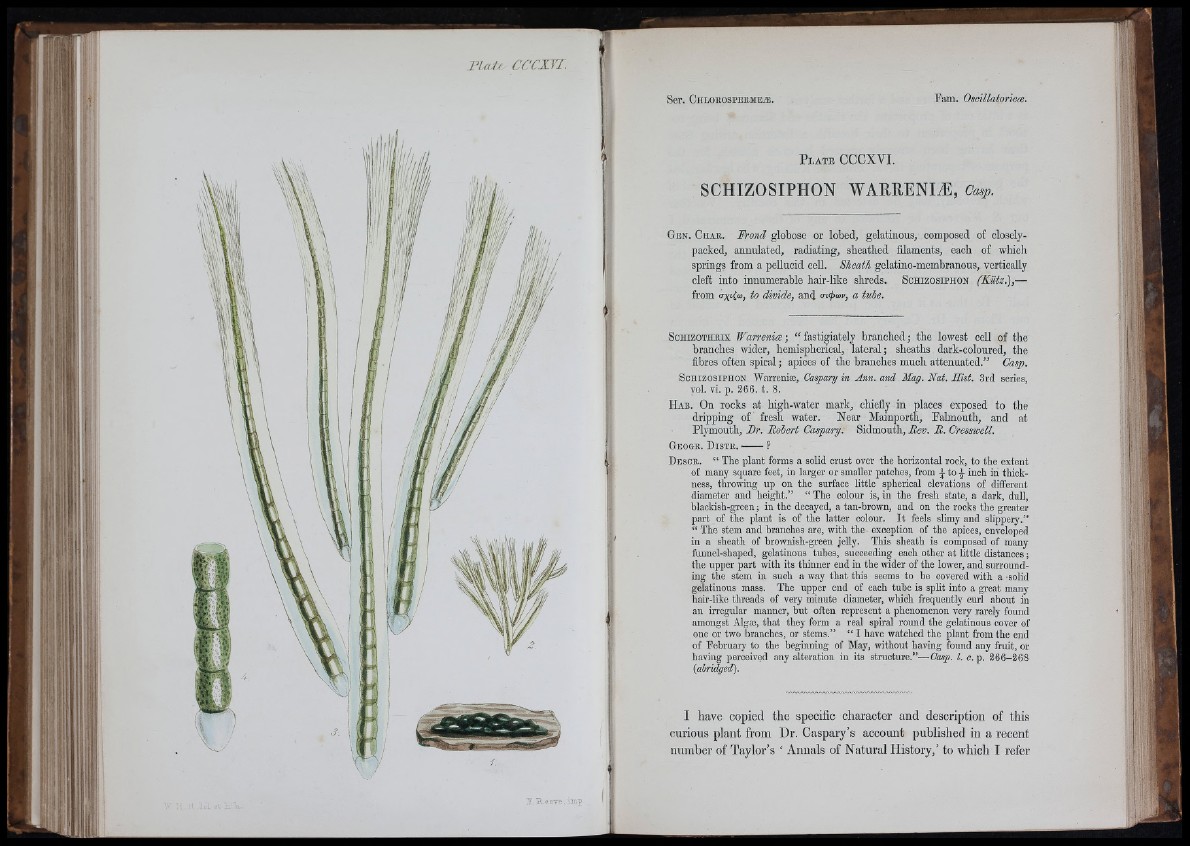
y
i i Uí-
P l a t e CCCXVI.
SCHIZOSIPHON WARRENI.E, Casp.
G en . Ch a r . Frond globose or lobed, gelatinous, composed of closely-
packed, annulated, radiating, sheathed filaments, each of which
springs from a peUuoid cell. Sheath gelatino-membranous, vertically
cleft into innumerable hair-like shreds. Sohizosiphon (Kiitz.),—
from to divide, and o-ajnov, a tube.
So hizotheix Warrenia; “ fastigiately branched; the lowest cell of the
branches wider, hemispherical, lateral; sheaths dark-coloured, the
fibres often spiral; apices of the branches much attenuated.” Casp.
S o h iz o s i p h o n Warrenia?, Caspary in Ann. and Mag. Nat. Hist. Srd series,
vol. vi. p. 266. t. 8.
Hab . On rooks at high-water mark, chiefly in places exposed to the
dripping of fresh water. Near Mainporth, Falmouth, and at
Plymouth, Dr. Robert Caspary. Sidmouth, Rev. R . Cresswell.
G e o g r . D i s t r . ?
D e s c e . “ The plant forms a solid crust over the horizontal rock, to the extent
of many square feet, in larger or smaller patches, from I to i inch in thickness,
throwing up on the surface little spherical elevations of different
diameter and height.” “ The colour is, in the fresh state, a dark, dull,
blackish-green; in the decayed, a tan-brown, and on the rocks the greater
part of the plant is of the latter colour. I t feels sHmy and slippery.”
“ The stem and branches are, with the exception of the apices, enveloped
in a sheath of brownish-green jelly. This sheath is composed of many
funnel-shaped, gelatinous tubes, succeeding each other at little distances;
the upper part with its thinner end in the wider of the lower, and surrounding
the stem in such a way that this seems to be covered with a solid
gelatinous mass. The upper end of each tube is split into a great many
hair-hke threads of very minute diameter, which frequently curl about in
an irregular manner, but often represent a phenomenon very rarely found
amongst Algse, that they form a real spiral round the gelatinous cover of
one or two branches, or stems.” “ I have watched the plant from the end
of February to the beginniug of May, without having found any fruit, or
having perceived any alteration in its structure.”— Cosy;. I. c. p. 266-268
I have copied the specific character and description of this
curious plant from Dr. Oaspary’s account published in a recent
number of Taylor’s ‘ Annals of Natural History,’ to which I refer
’h >•!